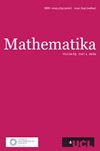图上的距离和和在欧氏空间中的嵌入
IF 0.8
3区 数学
Q2 MATHEMATICS
引用次数: 1
摘要
设G=(V,E)$G=(V,E)$是一个有限连通图。我们考虑顶点的贪婪选择:给定一个顶点列表x1,,xk$x_1,\dots,x_k$,取xk+1$x_{k+1}$为任何顶点,使到已经选择的顶点的距离之和最大化并迭代,不断添加“最远”的顶点。图的顶点出现在这个序列中的频率收敛于一组具有良好性质的概率测度。这些度量的支持通常由相当少的顶点m≪|V|$m\ll|V|$给出。我们证明,这表明图G在适当的意义上是“m维”的,通过表现出显式的1‐Lipschitz嵌入→ℓ1(Rm)$\phi:V\rightarrow\ell^1(\mathbb{R}^m)$,具有良好的性质。本文章由计算机程序翻译,如有差异,请以英文原文为准。
Sums of distances on graphs and embeddings into Euclidean space
Let be a finite, connected graph. We consider a greedy selection of vertices: given a list of vertices , take to be any vertex maximizing the sum of distances to the vertices already chosen and iterate, keep adding the “most remote” vertex. The frequency with which the vertices of the graph appear in this sequence converges to a set of probability measures with nice properties. The support of these measures is, generically, given by a rather small number of vertices . We prove that this suggests that the graph G is, in a suitable sense, “m-dimensional” by exhibiting an explicit 1-Lipschitz embedding with good properties.
求助全文
通过发布文献求助,成功后即可免费获取论文全文。
去求助
来源期刊

Mathematika
MATHEMATICS, APPLIED-MATHEMATICS
CiteScore
1.40
自引率
0.00%
发文量
60
审稿时长
>12 weeks
期刊介绍:
Mathematika publishes both pure and applied mathematical articles and has done so continuously since its founding by Harold Davenport in the 1950s. The traditional emphasis has been towards the purer side of mathematics but applied mathematics and articles addressing both aspects are equally welcome. The journal is published by the London Mathematical Society, on behalf of its owner University College London, and will continue to publish research papers of the highest mathematical quality.
 求助内容:
求助内容: 应助结果提醒方式:
应助结果提醒方式:


